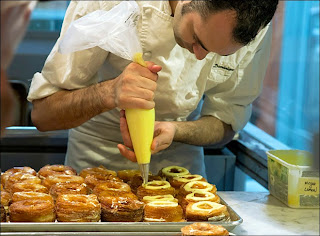11.11.14
Printing dough
You'll get that title after the next paragraph...
In last week's annual food issue of The New Yorker, Adam Gopnik wrote an article about the transition of pastry cuisine from a tradition-based craft, successfully repeating the same result from a few simple ingredients, to the current fad for innovation and personal creativity. (He focuses on the pretzel croissant and Cronut to tell the story.) It struck me while reading the article that it could just as easily be about the role and place of letterpress printing in contemporary society, simply told using baking as a metaphor. It's the difference between an exercise in typographic & printing austerity versus a form-bending "book object." Cobden-Sanderson vs Keith Smith. Croissant vs cupcake.
The article discusses apprenticeships, the slim profit margins on a labor-intensive endeavor with expensive material costs, and the marketing of a non-essential, luxury item. Sound familiar? Gopnik mentions the three designations the French use to distinguish between someone who bakes bread, someone who has a pastry shop, and a pastry chef in a restaurant. In letterpress printing, especially among those who are working as private press publishers, people usually start from a specific perspective: someone who likes working with types; someone who likes printing & working with old machines; a writer; a bookbinder. For these people, the other activities involved in publishing a book are always secondary to the one that attracted them in the first place.
One of the two bakers featured in the article is a traditionalist who thinks the focus on innovation has eclipsed a foundational appreciation for the basics of the craft. How many of the printers who want to ride a retro fad for letterpress are simply aping modern offset and digital aesthetics in deep relief?
The article's other baker discusses the question of supply: just because you can make more (e.g. once the press is running, why not just run off a bunch more copies?) doesn't mean you should. What he calls constancy - a consistency of quality - must be an overarching criterion. Limiting production is not simply a tactic for creating a sense of scarcity. As he explains, "Would it make money? Yes. Would it be good? No. Would I be proud of it? No. I would kill my own creation."
(The article's printing metaphor even extends to the first baker's disdain for the latter's work. Or perhaps more accurately, his discontent with the attention being paid?)
I liked Gopnik's explanation for the role comparatively expensive versions of everyday foods (bread, croissant) have come to play in people's lives. "The huge rise in the cost of raw materials...mean that either you lower quality or you keep it high and present the results as a special, once a week, wait-in-line treat." A similar thread to the one pulled a few blogs back, about the potential for the well-made book to enjoy a renaissance along side the e-book. We just have to get to the same place the pastry chefs have: "...to make the pastry so essential that its market becomes fairly price-insensitive."
Even if this premise is whiffle, Gopnik's article is a good read. Have a look.
AND ANOTHER THING...
...from the ongoing unpacking process (not exactly as shown above): a mid-'90s era typographic bookmark from Wessel & Lieberman.
The printer was Martin Wolf, aka Nemo Press, on Vancouver Island. (Don't think the address below is current, so don't bother writing.) I bought my first press, the Kelsey 5 x 8 from Marty. A few years later I heard he was divesting all his printing equipment, which included a huge Hoe Washington handpress. That supposedly was sold to a Japanese printing firm, which wanted it for a display in their foyer or some such. I'll find out if there were more in the promised series.








